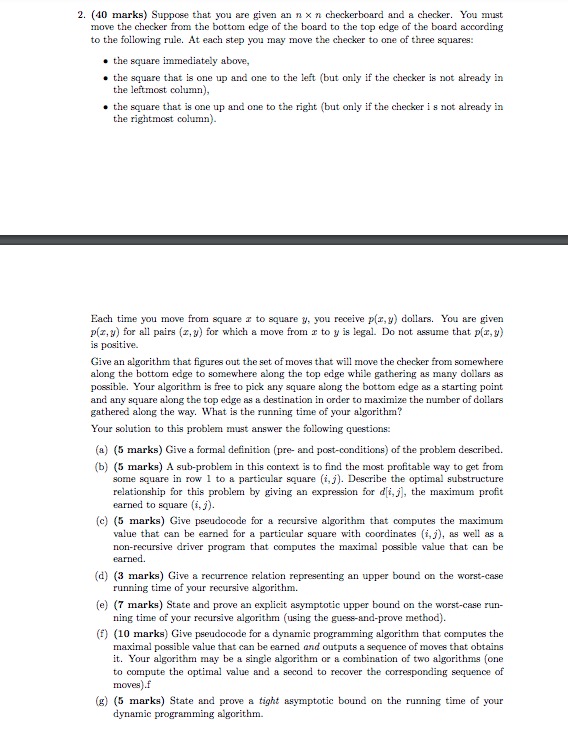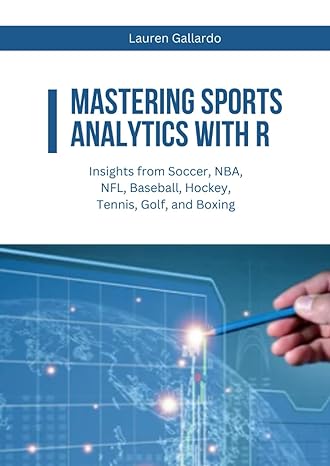
2, (40 marks) Suppose that you are given an n n checkerboard and a checker. You must move the checker from the bottom edge of the board to the top edge of the board according to the following rule. At each step you may move the checker to one of three squares: e the square immediately abov, e the square that is one up and one to the left (but only if the checker is not already in the leftmost column), the square that is one up and one to the right (but only if the checker i s not already in the rightmost column). Each time you move from square a to square y, you receive pfa, ) dollars. You are given p(z, g) for all pairs (x, y) for which a move from r to y is legal. Do not assume that p(r, g) is positive. Give an algorithm that figures out the set of moves that will move the checker from along the bottom edge to somewhere along the top edge while gathering as many dollars as possible. Your algorithm is free to pick any square along the bottom edge as a starting point and any square along the top edge as a destination in order to maximize the number of dollars gathered along the way. What is the running time of your algorithm? Your solution to this problem must answer the following questions: (a) (5 marks) Give a formal definition (pre- and post-conditions) of the problem described. (b) (5 marks) A sub-problem in this context is to find the most profitable way to get from some square in row 1 to a particular square (i,j). Describe the optimal substructure relationship for this problem by giving an expression for dfi,j], the maximum profit earned to square (,j). (c) (5 marks) Give pseudocode for a recursive algorithm that computes the maximum value that can be earned for a particular square with coordinates (i,j), as wel as a non-recursive driver program that computes the maximal possible value that can be earned running time of ning time (d) (3 marks) Give a recurrenoe relation representing an upper bound on the worst-case your recursive algorithm (e 7 marks) State and prove an explicit asymptotic upper bound on the worst-case run- of your recursive algorithm (using the (f) (10 marks) Give pseudocode for a dynamic programming algorithm that computes the maximal possible value that can be earned and outputs a sequence of moves that obtains it. Your algorithm may be a single algorithm or a combination of two algorithms (one to compute the optimal value and a second to recover the corresponding sequenoe of (g) (5 marks) State and prove a tight asymptotic bound on the running time of your dynami c programming algorithm. 2, (40 marks) Suppose that you are given an n n checkerboard and a checker. You must move the checker from the bottom edge of the board to the top edge of the board according to the following rule. At each step you may move the checker to one of three squares: e the square immediately abov, e the square that is one up and one to the left (but only if the checker is not already in the leftmost column), the square that is one up and one to the right (but only if the checker i s not already in the rightmost column). Each time you move from square a to square y, you receive pfa, ) dollars. You are given p(z, g) for all pairs (x, y) for which a move from r to y is legal. Do not assume that p(r, g) is positive. Give an algorithm that figures out the set of moves that will move the checker from along the bottom edge to somewhere along the top edge while gathering as many dollars as possible. Your algorithm is free to pick any square along the bottom edge as a starting point and any square along the top edge as a destination in order to maximize the number of dollars gathered along the way. What is the running time of your algorithm? Your solution to this problem must answer the following questions: (a) (5 marks) Give a formal definition (pre- and post-conditions) of the problem described. (b) (5 marks) A sub-problem in this context is to find the most profitable way to get from some square in row 1 to a particular square (i,j). Describe the optimal substructure relationship for this problem by giving an expression for dfi,j], the maximum profit earned to square (,j). (c) (5 marks) Give pseudocode for a recursive algorithm that computes the maximum value that can be earned for a particular square with coordinates (i,j), as wel as a non-recursive driver program that computes the maximal possible value that can be earned running time of ning time (d) (3 marks) Give a recurrenoe relation representing an upper bound on the worst-case your recursive algorithm (e 7 marks) State and prove an explicit asymptotic upper bound on the worst-case run- of your recursive algorithm (using the (f) (10 marks) Give pseudocode for a dynamic programming algorithm that computes the maximal possible value that can be earned and outputs a sequence of moves that obtains it. Your algorithm may be a single algorithm or a combination of two algorithms (one to compute the optimal value and a second to recover the corresponding sequenoe of (g) (5 marks) State and prove a tight asymptotic bound on the running time of your dynami c programming algorithm







